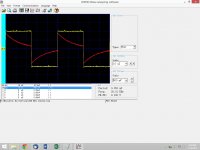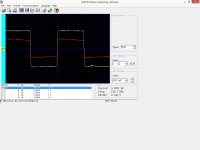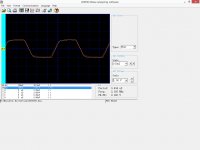the same applies to a series RL in parallel with a single resistor, the current "crowds" into the one resistor when the L blocks the fast current rise time
yes non-ferromagnetic conductors Al, Cu Ag, Au, Pt, Pd... just about anything sold as a pure, single metal high conductivity wire - although there is a fair amount steel core Cu plated wire used for strength too
I have also linked in the past to "Ordinary Magnetoresistance", the Corbino disk demonstration http://en.wikipedia.org/wiki/Magnetoresistance - a subtle effect requiring special geometry not present in simple wire/cable construction - and jn has stipulated that he isn't talking about this real, but real small effect
and you do get temperature coefficient modulation with heating too - but again not what jn appears to talking about
yes non-ferromagnetic conductors Al, Cu Ag, Au, Pt, Pd... just about anything sold as a pure, single metal high conductivity wire - although there is a fair amount steel core Cu plated wire used for strength too
I have also linked in the past to "Ordinary Magnetoresistance", the Corbino disk demonstration http://en.wikipedia.org/wiki/Magnetoresistance - a subtle effect requiring special geometry not present in simple wire/cable construction - and jn has stipulated that he isn't talking about this real, but real small effect
and you do get temperature coefficient modulation with heating too - but again not what jn appears to talking about
Last edited:
No.Depends on wire material, right? Copper - no nonlinear distortion. Iron - distortion is possible.
the same applies to a series RL in parallel with a single resistor, the current "crowds" into the one resistor when the L blocks the fast current rise time
A very excellent model that almost describes the system accurately. It is indeed, what is used by the SMPS guys to approximate reality.
jn
Non-linear distortion means that new frequencies that were not present in the input signal are created. Skin effect does not create non-linear distortion. Let's not confuse non-linear distortion and transients.
I am not confusing the two.
jn
Non-linear distortion means that new frequencies that were not present in the input signal are created. Skin effect does not create non-linear distortion. Let's not confuse non-linear distortion and transients.
Pavel,
Copper has a temperature related coefficient of resistance. Crowd the current the temperature rises and the resistance changes. You knew that. What is not clear is that at higher frequencies the copper oxide is a nonlinear resistance as are surface cracks.
I expect you know how fractures propagate in solids.
ES
PS you have no idea how it pains me to agree with JN!
PS you have no idea how it pains me to agree with JN!
Obviously I must be incorrect. Gonna hafta rethink my beliefs..
jn
Obviously I must be incorrect. Gonna hafta rethink my beliefs..
jn
Start at "I think therefore..." Oops that may not work...
Pavel,
Copper has a temperature related coefficient of resistance. Crowd the current the temperature rises and the resistance changes. You knew that. What is not clear is that at higher frequencies the copper oxide is a nonlinear resistance as are surface cracks.
I expect you know how fractures propagate in solids.
ES
PS you have no idea how it pains me to agree with JN!
None of these things have anything to do with jn's effect in fact if they existed they would confound his attempt to demonstrate it. Anyway I doubt the temperature of the CU could even remotely change at the slew rates needed.
Is it fair to ask for a reference to the non-linear resistance of surface cracks? Also you changed the rules again jn is talking about HUGE currents, I thought these mystery properties were hidden in the passage of a few electrons per second.
Last edited:
Start at "I think therefore..." Oops that may not work...
Now we agree.
jn
Now we agree.
jn
Again!
Bonsai posted a really cute toy. All I can do is show the results of my latest miniature current monitor. It goes low enough in frequency that my Tek Hall effect unit will cover anything down there and goes higher than my current function generator and from the square wave response probably is flat to 20 MHz.
The yellow trace is the voltage across my current source 100 ohm resistor.
Attachments
Last edited:
None of these things have anything to do with jn's effect in fact if they existed they would confound his attempt to demonstrate it. Anyway I doubt the temperature of the CU could even remotely change at the slew rates needed.
Is it fair to ask for a reference to the non-linear resistance of surface cracks? Also you changed the rules again jn is talking about HUGE currents, I thought these mystery properties were hidden in the passage of a few electrons per second.
We were talking 60 hertz. As to the reference let's start with the PIM article Demian cited. Then we can talk about how surface cracks begin to form around a defect in the material which can be an oxide or other junk. I presume you have seen one of those cool videos showing how cracks form and move in solids.
JN is talking about his work. Painful as it is there is a chance he knows what he is talking about.
My work is as you mention quite different. I don't think heat has anything to do with what I am looking at.
Sorry if I confused you.
Again!
Bonsai posted a really cute toy. All I can do is show the results of my latest miniature current monitor. It goes low enough in frequency that my Tek Hall effect unit will cover anything down there and goes higher than my current function generator and from the square wave response probably is flat to 20 MHz.
Now, what is the precise schematic of what we're looking at in the two waveforms?
And when are we going to see some diode recovery waveforms??
Nice work Ed..
I have to laugh...I'm designing up a micro-wire/plunge EDM system to make .002 to .004 inch holes centered in the end of hardened watch balance staffs of .015 inch diameter, so just ordered some brass, aluminum, and stainless tubes online to machine for the 8mm split chuck holder.... Now, all I see on my web pages are directed advertisements for brass and aluminum...
jn
Now, what is the precise schematic of what we're looking at in the two waveforms?
And when are we going to see some diode recovery waveforms??
Nice work Ed..
I have to laugh...I'm designing up a micro-wire/plunge EDM system to make .002 to .004 inch holes centered in the end of hardened watch balance staffs of .015 inch diameter, so just ordered some brass, aluminum, and stainless tubes online to machine for the 8mm split chuck holder.... Now, all I see on my web pages are directed advertisements for brass and aluminum...
jn
My current transformer is loaded by a 15 ohm resistor nothing funny. Yellow is the voltage across a 100 ohm resistor the red is what the current probe shows when the resistor lead is inside the probe.
Then we can talk about how surface cracks begin to form around a defect in the material which can be an oxide or other junk. I presume you have seen one of those cool videos showing how cracks form and move in solids.
Avoiding a simple answer to a direct question as usual, references to any just ANY research on non-linearity due to wire surface cracks. Oh BTW the surfaces on the tiny metal runs on 24 bit A/D's and D/A's are pretty bad looking, I could show you some SEM photos.
Last edited:
Avoiding a simple answer to a direct question as usual, references to any just ANY research on non-linearity due to wire surface cracks. Oh BTW the surfaces on the tiny metal runs on 24 bit A/D's and D/A's are pretty bad looking, I could show you some SEM photos.
I am finally getting around to unpacking my library. Should be about three more months till it is finished.
But as I have proposed before there is an optimum conductor dize based on current frequency and load. Now have you ever compared the once with lots of defects to ones with few?
I just googled passive intermodulation distortion surface scratches and got a bunch of papers. They list the issues a being localized resistance changes, oxide formation an other defects. What exactly do you want?
Last edited:
I am finally getting around to unpacking my library. Should be about three more months till it is finished.
But as I have proposed before there is an optimum conductor dize based on current frequency and load. Now have you ever compared the once with lots of defects to ones with few?
Not much point, all distortion is accounted for down to the noise in most cases. The switched cap guys are chasing zepto-farads. To put it simply these effects are not observed anywhere.
Give me anything, as I said these concerns never turn up anywhere in our business except in pathological situations, it's broke fix it.
Last edited:
Nothing like a bit of Googling - some more of the thinking here ... Audio Asylum Thread Printer
Nothing like a bit of Googling - some more of the thinking here ... Audio Asylum Thread Printer
Let's stick with audio frequency effects please.
Let's stick with audio frequency effects please.
That was nicely circular. JN in another forum.
- Status
- Not open for further replies.
- Home
- Member Areas
- The Lounge
- John Curl's Blowtorch preamplifier part II


